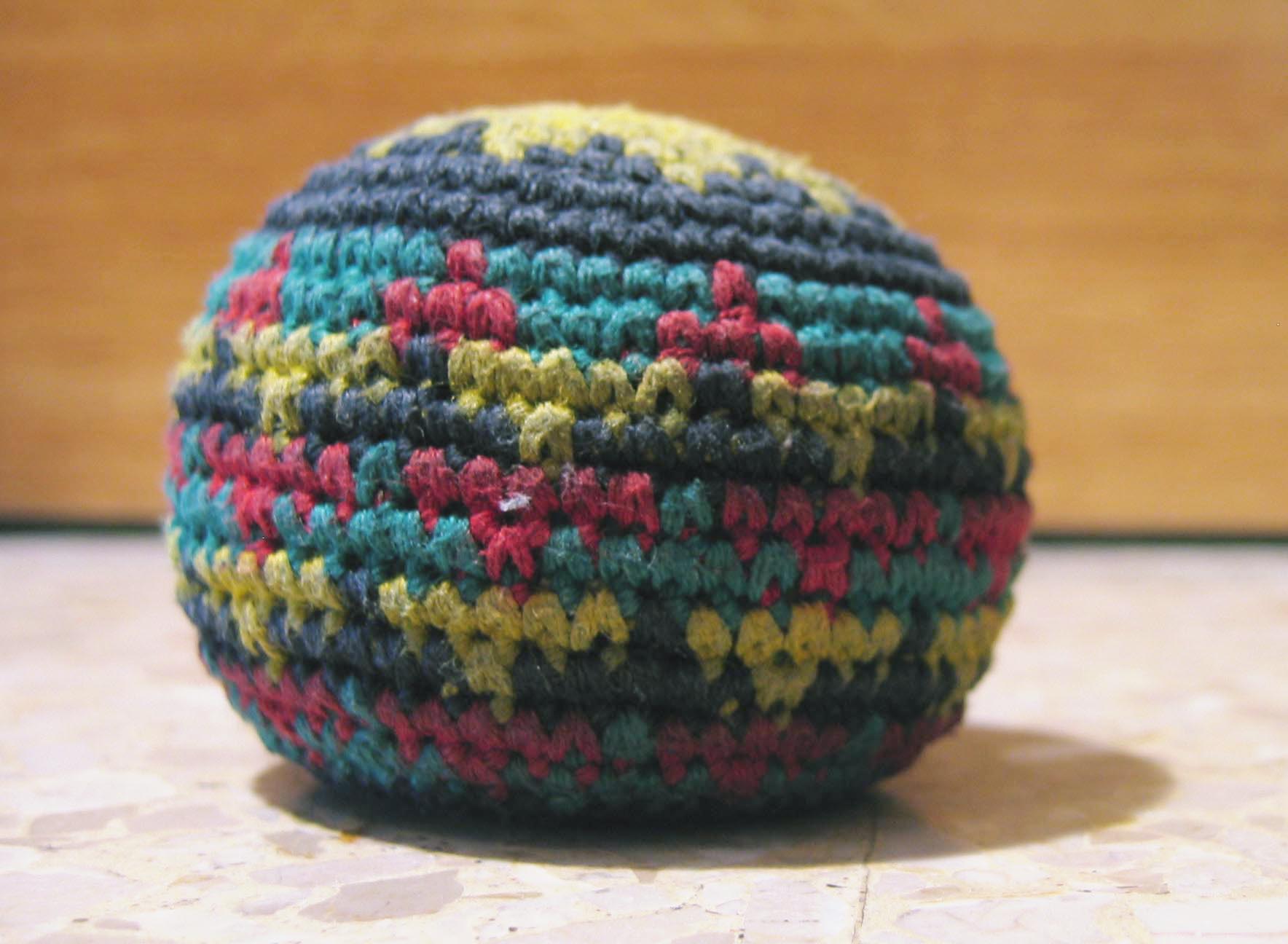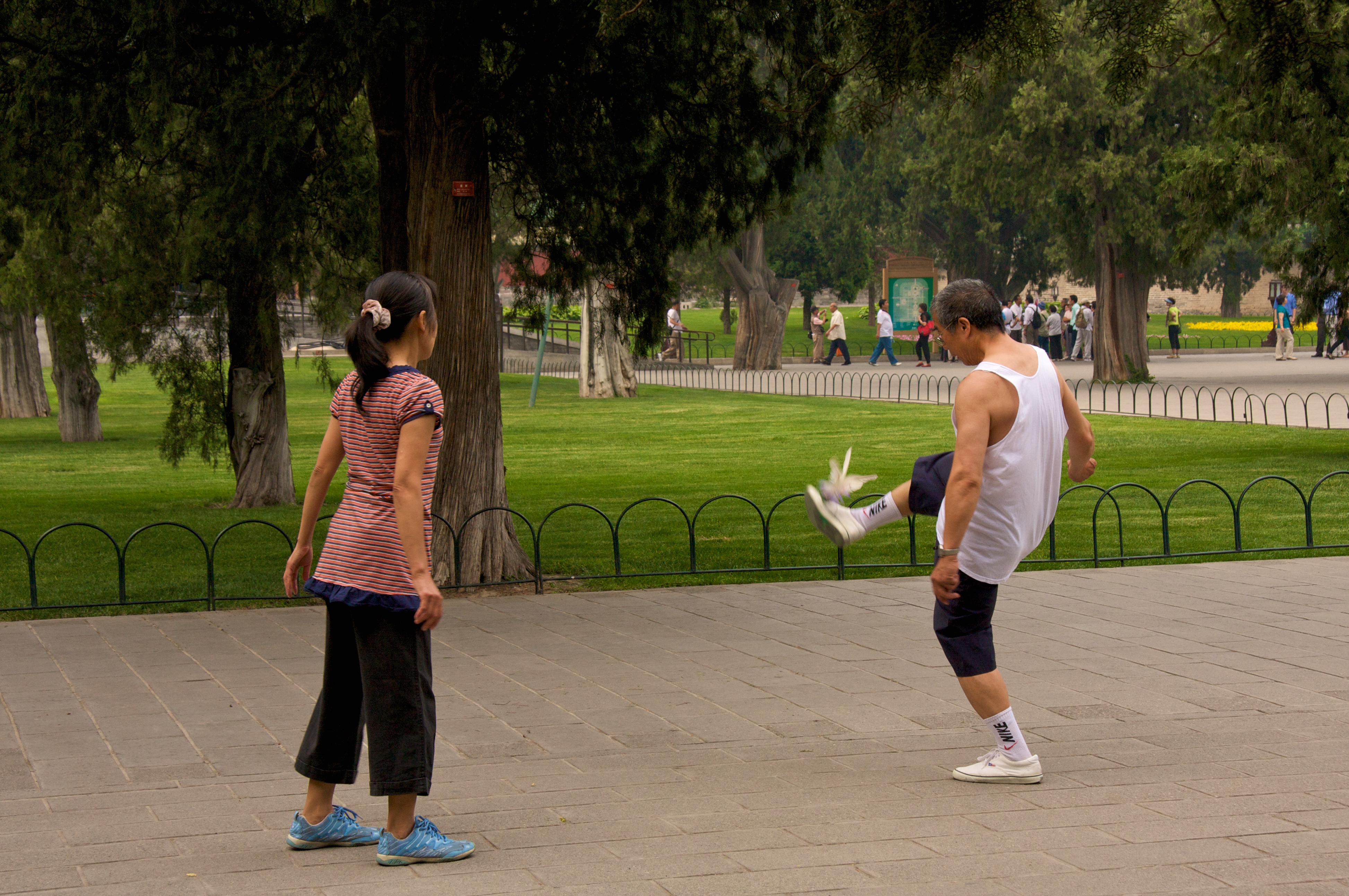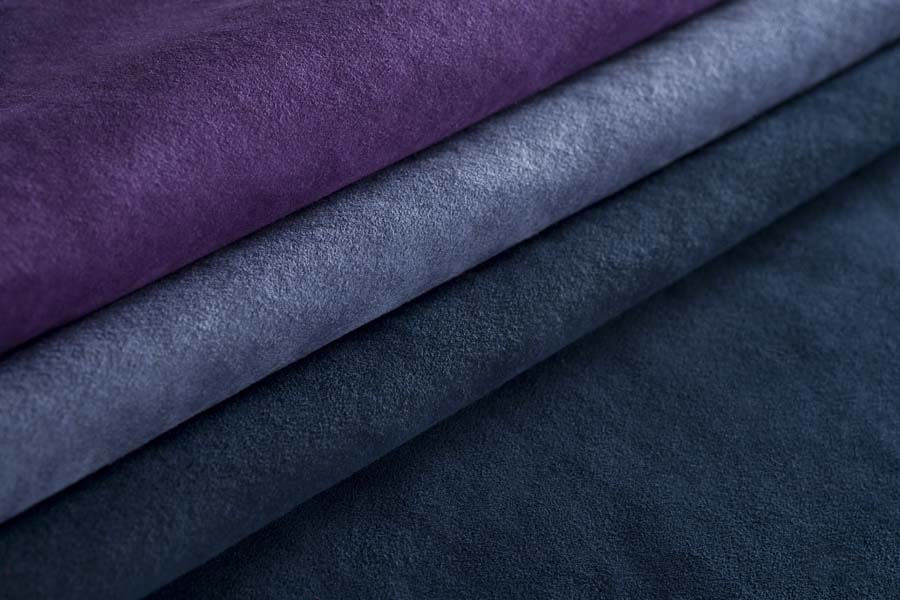|
Footbag
A footbag is a small, round bag usually filled with plastic pellets or sand, which is kicked into the air as part of a competitive game or as a display of dexterity. "Hacky Sack" is the name of a brand of footbag popular in the 1970s (currently owned by Wham-O), which has since become a generic trademark. The most common game of footbag consists of two or more players standing in a circle and trying to keep the sack off the ground for as long as possible. History Footbag-like activities have existed for many years. The game is similar to traditional Asian games of kicking the shuttlecock, known as ''jianzi'' or ''chapteh''. The game is also similar to some South East Asian games, such as ''chinlone'', ''sepak takraw'' and ''sipa''. This game is known as ''jegichagi'' (제기차기) in Korea. The Wu Style Tai Chi Chuan practice dates back to at least the 1930s, and French policemen are seen playing a shuttlecock game in the 1955 American film ''To Catch a Thief''. The same princip ... [...More Info...] [...Related Items...] OR: [Wikipedia] [Google] [Baidu] |
Jan Weber
Jan Weber (also known as wikt:Honza, Honza Weber, born 28 August 1986) is multiple World and European Freestyle footbag champion. He has been playing footbag since 2001 and since 2002 competed at more than 200 professional footbag events and performed at more than 2000 public events. He had gained his Master degree at the University of Economics, Prague and later became a professional freestyler. The biggest successes Weber achieved are 4 World Champion titles in doubles Freestyle footbag and also 4 World Champion titles in singles discipline, 3 in a row in years 2011, 2012 and 2013. After that Weber stopped competing and was primarily focusing on live shows and footbag promotion. However in 2020 he returned after 7 years for an online World championships, where he gained his 8th World Champion title and remained unbeaten. Weber has also started to play Freestyle football in 2010. He was a member of the organising crew of the first annual European Freestyle football in 2010 and ... [...More Info...] [...Related Items...] OR: [Wikipedia] [Google] [Baidu] |
Mike Marshall (inventor)
Mike Marshall (ca. 1947 – 1975) was an American inventor best known for his co-invention, with John Stalberger, of the sport footbag and the Hacky Sack in 1972. Marshall was living in Oregon when he met Stalberger. Stalberger was undergoing rehabilitation for his knee and so he began to exercise with Marshall, who was kicking around a homemade beanbag. Marshall died in 1975 at the age of 28 from a fatal heart attack A myocardial infarction (MI), commonly known as a heart attack, occurs when blood flow decreases or stops to the coronary artery of the heart, causing damage to the heart muscle. The most common symptom is chest pain or discomfort which may tr .... He was inducted into the Footbag Hall of Fame in 1999. The Footbagger of the Year award changed its name in 1990 to the Mike Marshall Award in his memory. References The Secret History of Balls: The Stories Behind the Things We Love to Catch [...More Info...] [...Related Items...] OR: [Wikipedia] [Google] [Baidu] |
Jianzi
Jianzi (), tī jianzi (踢毽子), tī jian (踢毽) or jianqiú (毽球), is a traditional Chinese national sport in which players aim to keep a heavily weighted shuttlecock in the air by using their bodies, apart from the hands, unlike in similar games Peteca and Indiaca. The primary source of jianzi is a Chinese ancient game called '' Cuju'' of the Han dynasty 2,000 years ago. Jianzi's competitive sport types are played on a badminton court using inner or outer lines in different types of jianzi's competitive sports, respectively. It can also be played artistically, among a circle of players in a street or park, with the objective to keep the shuttle 'up' and show off skills. In Vietnam, it is known as ''đá cầu'' and is the national sport. In the Philippines, it is known as ''sipa'' and was also the national sport until it was replaced by arnis in December 2009. In recent years, the game has gained a formal following in around the globe. In English, both the sport and th ... [...More Info...] [...Related Items...] OR: [Wikipedia] [Google] [Baidu] |
Sipa
Sipa (literally, "kick") is the Philippines' traditional native sport which predates the Spanish rule. The game is related to Sepak Takraw. Similar games include Footbag net, Footvolley, Bossaball and Jianzi. The game is both played by two teams, indoors or outdoors, on a court that is about the size of a tennis court. The teams consist of one, two or four players in each side. The aim of the game is to kick a soft ball made out of rattan fragments, back and forth over a net in the middle of the court. The sport requires speed, agility and ball control. A point is awarded every time a player kicks the ball, the more the player kicks the ball, the more the points accumulate. Rules attached to the game are very minimal and even children can play, but the ratan ball version is preferred more for formal games. Washer version One version of Sipa uses a lead washer covered with cloth, which gets kicked. This version is played by both girls and boys, but girls tend to use the outs ... [...More Info...] [...Related Items...] OR: [Wikipedia] [Google] [Baidu] |
Chain Mail
Chain mail (properly called mail or maille but usually called chain mail or chainmail) is a type of armour consisting of small metal rings linked together in a pattern to form a mesh. It was in common military use between the 3rd century BC and the 16th century AD in Europe, and longer in Asia and North Africa. A coat of this armour is often called a hauberk, and sometimes a byrnie. History The earliest examples of surviving mail were found in the Carpathian Basin at a burial in Horný Jatov, Slovakia dated at 3rd century BC, and in a chieftain's burial located in Ciumești, Romania. Its invention is commonly credited to the Celts, [...More Info...] [...Related Items...] OR: [Wikipedia] [Google] [Baidu] |
Tungsten
Tungsten, or wolfram, is a chemical element with the symbol W and atomic number 74. Tungsten is a rare metal found naturally on Earth almost exclusively as compounds with other elements. It was identified as a new element in 1781 and first isolated as a metal in 1783. Its important ores include scheelite and wolframite, the latter lending the element its alternate name. The free element is remarkable for its robustness, especially the fact that it has the highest melting point of all known elements barring carbon (which sublimes at normal pressure), melting at . It also has the highest boiling point, at . Its density is , comparable with that of uranium and gold, and much higher (about 1.7 times) than that of lead. Polycrystalline tungsten is an intrinsically brittle and hard material (under standard conditions, when uncombined), making it difficult to work. However, pure single-crystalline tungsten is more ductile and can be cut with a hard-steel hacksaw. Tungsten occurs in many ... [...More Info...] [...Related Items...] OR: [Wikipedia] [Google] [Baidu] |
Ultrasuede
Ultrasuede is the trade name for a synthetic ultra-microfiber fabric invented in 1970 by Dr. Miyoshi Okamoto, a scientist working for Toray Industries. In Japan, it is sold under the brand name Ecsaine. It is often described as an artificial substitute for suede leather. The fabric is multifunctional: it is used in fashion, interior decorating, automobile and other vehicle upholstery, and industrial applications, such as protective fabric for electronic equipment. It is also a very popular fabric in the manufacture of footbags (also known as hacky sacks) and juggling balls. Other manufacturers such as Sensuede and Majilite also produce similar product lines of synthetic microfiber suede. Composition Fabric content ranges from 80% polyester non-woven (100% recycled ultra-microfiber) and 20% non-fibrous polyurethane to 65% polyester and 35% polyurethane, depending on the product line. Ultrasuede feels like natural suede, but it is resistant to stains and discoloration; it can be ... [...More Info...] [...Related Items...] OR: [Wikipedia] [Google] [Baidu] |
Clarino
is a brand name for artificial leather manufactured by Kuraray Co., Ltd. of Japan. It is commonly used in gloves, footwear, handbags, and law enforcement duty gear. Versions are made that simulate suede and top-grain leather. Being a man-made material, it is washable and retains its softness when wet, unlike natural leather. After many decades of development, Clarino has achieved performance that exceeds that of leather in some applications, especially where the item may be exposed to water, such as riding saddles. Top grain leather applications include "patent leather" shoes that retain high gloss without the need for polish. During manufacturing, it is microscopically perforated to give it breathability similar to that of natural leather. Clarino is based on a non-woven fabric composed of special synthetic fibers that are intertwined three-dimensionally. The material's softness and suppleness arise from the structure of the non-woven fabric's special fibers, superfine fiber c ... [...More Info...] [...Related Items...] OR: [Wikipedia] [Google] [Baidu] |
Phosphorescence
Phosphorescence is a type of photoluminescence related to fluorescence. When exposed to light (radiation) of a shorter wavelength, a phosphorescent substance will glow, absorbing the light and reemitting it at a longer wavelength. Unlike fluorescence, a phosphorescent material does not immediately reemit the radiation it absorbs. Instead, a phosphorescent material absorbs some of the radiation energy and reemits it for a much longer time after the radiation source is removed. In a general sense, there is no distinct boundary between the emission times of fluorescence and phosphorescence (i.e.: if a substance glows under a black light it is generally considered fluorescent, and if it glows in the dark it is often simply called phosphorescent). In a modern, scientific sense, the phenomena can usually be classified by the three different mechanisms that produce the light, and the typical timescales during which those mechanisms emit light. Whereas fluorescent materials stop emit ... [...More Info...] [...Related Items...] OR: [Wikipedia] [Google] [Baidu] |
Flame Retardant
The term flame retardants subsumes a diverse group of chemicals that are added to manufactured materials, such as plastics and textiles, and surface finishes and coatings. Flame retardants are activated by the presence of an ignition source and are intended to prevent or slow the further development of ignition by a variety of different physical and chemical methods. They may be added as a copolymer during the polymerisation process, or later added to the polymer at a moulding or extrusion process or (particularly for textiles) applied as a topical finish. Mineral flame retardants are typically additive while organohalogen and organophosphorus compounds can be either reactive or additive. Classes Both Reactive and Additive Flame retardants types, can be further separated into four distinct classes: * Minerals such as aluminium hydroxide (ATH), magnesium hydroxide (MDH), huntite and hydromagnesite, various hydrates, red phosphorus, and boron compounds, mostly borates. * Organ ... [...More Info...] [...Related Items...] OR: [Wikipedia] [Google] [Baidu] |
Crochet
Crochet (; ) is a process of creating textiles by using a crochet hook to interlock loops of yarn, thread (yarn), thread, or strands of other materials. The name is derived from the French term ''crochet'', meaning 'hook'. Hooks can be made from a variety of materials, such as metal, wood, bamboo, or plastic. The key difference between crochet and knitting, beyond the implements used for their production, is that each stitch in crochet is completed before the next one is begun, while knitting keeps many stitches open at a time. Some variant forms of crochet, such as Tunisian crochet and broomstick lace, do keep multiple crochet stitches open at a time. Etymology The word crochet is derived from the Old French ''crochet'', a diminutive of ''croche'', in turn from the Germanic languages, Germanic ''croc'', both meaning "hook". It was used in 17th-century French lace-making, where the term ''crochetage'' designated a stitch used to join separate pieces of lace. The word ''crochet'' ... [...More Info...] [...Related Items...] OR: [Wikipedia] [Google] [Baidu] |





.jpg)
